LESSON 21: Sleight-of-Hand with Coins
You have now reached the stage where you are ready for sleights with coins. This field of coin manipulation is a vast one and a thorough knowledge of it will add much to your Magical Education. Other small objects may be handled in a manner similar to coin sleights. Consequently when you have mastered the manipulations in this lesson you have proceeded a long way in your mastery of Sleight of Hand.
T. Nelson Downs is a King of Coins. He built a great reputation by specializing in Coin Magic, and at one time his act was imitated more than any other in the realm of Magic. Who will forget his famous Miser's Dream in which coin after coin was plucked from the air and dropped with a jingle into a borrowed hat? I do so wish that every one of my students could see this expert coin manipulator at work.
Another expert in coin manipulations is Manuel, Master of the Mighty Dollar, as he styles himself. His work is a revelation in coin sleights.
I teach you a great many principles of coin sleights in this lesson. This is to give you a firm foundation in the art.
Practice well and MASTER every movement I give you and your reward will be a variety of methods at your command for vanishing and appearing a coin or other small object.
Many of these principles are very simple in operation; others I have analyzed and simplified to such an extent that careful study of the illustrations will enable you to learn them without difficulty. I have illustrated this lesson so profusely that there need be no doubt about any move.
The fundamentals of Magic which are very important in these manipulations are:
• Angles of Visibility
• Naturalness
• Misdirection
Stand before your mirror and watch your reflection closely so that you learn to do these manipulations correctly.
The first thing for you to do is to review the section on the ART OF MISDIRECTION in LESSON 3. This is absolutely essential as your beginning in learning coin sleights.
There are many types of hands and some methods of manipulation lend themselves better to one type than to another. Practice them all, however, and then you can discover for yourself to which methods your hands are best adapted.
The most popular coin for general use is the half dollar. Start with a coin that has a fairly good milled edge. I send you FREE for this lesson three Palming Coins. You will find them fine for manipulation work as the edges are well milled and permit of a firm grip. I advise you to purchase about 2 dozen of these coins as you will find them invaluable in future coin tricks. We can supply you with them at $1.00 a dozen.
I. PALMING USED IN COIN SLEIGHTS
1 -- Front Flat Palm.
This is the ordinary palm in which the coin is held flat against the palm. Slight pressure of the fleshy part of the base of thumb and third and fourth fingers holds the coin. The fingers should be slightly curled and the whole hand must be held in an easy, natural position. Avoid any awkward movement of trying to stretch the fingers and thumb outward. Figure 1.
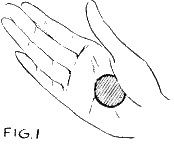
2 -- Pressure Palm.
This is a very easy way of concealing a coin. The coin is placed flat against the palm as in the Front Flat Palm, but in this method the third finger tip holds it against palm of hand. Figure 2.
You can hold your hand in a perfectly natural manner in using this method. The third and fourth fingers curl under and the thumb and first two fingers are straight. Figure 3 shows hand as it looks to audience.
3 -- Front Edge Palm.
Coin is palmed by its edge. It is held in a slanting position between the fleshy base of thumb and base of fourth finger. Figure 4.

4 -- Front Thumb Palm.
Very convenient to use. Coin is held between thumb and base of first finger. Care must be taken that coin is well inside of the hand and does not show from back of hand. Figure 5.

5 -- Back Thumb Palm.
Coin is held in crotch of thumb and first finger. Coin is at back of hand so that palm of hand can be shown freely without detection. Figure 6.
6 -- Invisible Thumb Palm.
This palm is excellent for you can show both sides of hand and yet have the coin concealed.
Coin is held in a horizontal position between base of first finger and thumb. First joint is turned downward slightly. Figure 7.
Figure 8A shows view from above.

Figure 8B shows hand as it looks to audience. You may show front and back without having anyone detect the concealed coin.

7 -- Finger Palm.
You learned this palm in Lesson 1. Coin is held at third joint of second and third fingers. These two fingers are slightly curved to hold it securely. Rest of fingers are held naturally. Figure 9.

8 -- Curled Finger Tip Palm.
This is also a simple palm in which coin is held between second and third fingers near the tips. The fingers are curled into the palm with other fingers held naturally. This method is very useful in change-over palming from one hand to another. Figure 10.
9 -- Front Finger Palm.
Coin rests flat on second and third fingers over the second joints. On each side the coin is gripped by the first joints of both first and little fingers. If second and third fingers are moved away, coin must still be gripped by other two fingers. Figure 11.

10 -- Back Finger Palm.
Similar to palm described above except that coin is held on back of hand. It rests flat over second joints of second and third fingers and is gripped on its edges by first and little fingers. Figure 12.
11 -- Front Finger Clip.
Coin is gripped securely between first and second joints of first and second fingers with the coin toward palm of hand. It must not be seen from back of hand. Figure 13.
12 -- Back Finger Clip.
Similar to Front Finger Clip, except that coin is held to back of hand. It must not be visible from front of hand. Figure 14.

13 -- Closed Finger Palm.
Coin is held in place by being gripped in second joint of third finger and crease in palm as hand is partially closed. Other fingers are held naturally. Figure 15.
The thirteen methods of palming described above cover those used in the ordinary realm of coin sleights for concealing and producing coins.
Now we proceed to methods of holding coins while they are visible to audience.
HOLDS USED IN COIN SLEIGHTS
1 -- Finger Tip Clip.
Hold coin at tips of fingers so that as much of coin as possible is visible, yet with enough between fingers to permit you to grip it securely. Figure 16.
2 -- Two Finger Balance.
Balance coin at tips of any two fingers next to each other. Figure 17.

3 -- Thumb-Fingertip Horizontal Hold.
Grip coin in a horizontal position at tips of thumb and first three fingers. Figure 18.
4 -- Thumb-Fingertip Vertical Hold.
Hold coin in vertical position between tips of thumb and first two fingers.
Figure 19 shows view away from audience and toward performer. Figure 20 shows hand and coin as seen by audience.
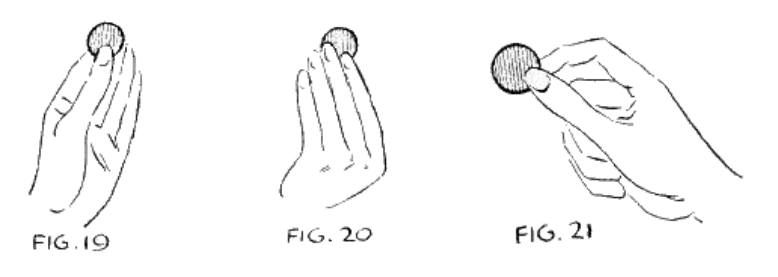
5 -- Production Clip.
This is an excellent hold for production of coins in the "Miser's Dream" and other coin productions. Hold coin between tips of thumb and index finger. Practice letting coin come from various holds and palms to this Production Clip. Figure 21.
6 -- Pinch Clip.
Hold coin by edges between tips of thumb and first finger. Figure 22.

7 -- Flat Finger Position.
Hold coin flat on two middle fingers, near the base as shown in Figure 23.
8 -- Fist Horizontal and Fist Vertical Holds.
Lay coin flat on top of closed hand over the thumb and first finger. Figure 24.

Clip coin vertically into curled index finger with fist closed. Figure 25.
To vanish coin pretend to pick it up with right fingertips. When covered by fingers let coin drop into closed left hand. Carry right hand away as though containing coin. Open hand and show coin has vanished.
MANIPULATIVE METHODS FOR VANISHING A COIN
1 -- Front Thumb Palm Vanish.
Have coin in Finger Tip Clip position in right hand. Figure 26.
Pretend to throw coin into open left hand, but as right hand makes motion of throwing towards left hand, curve the first and second fingers with coin inward to crotch of thumb. Figure 27.
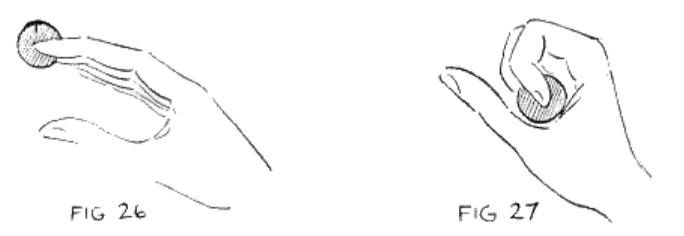
Close thumb against coin until it is held in regular Front Thumb Palm position. When coin is secure, fingers, of course, are straightened out. Figure 28.
Right hand continues its movement without a noticeable pause and goes to left hand, which should be quickly closed about it. Figure 29.
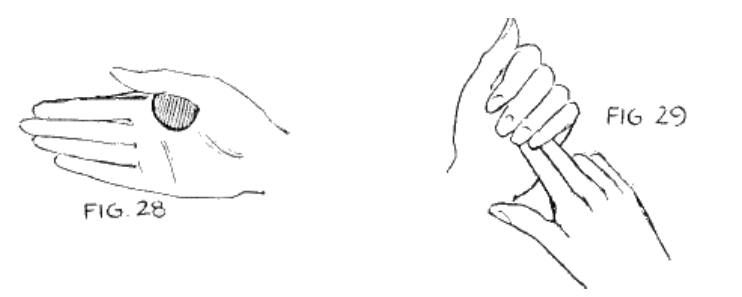
To the audience it appears that you have actually placed coin in left hand. Withdraw right hand, still holding coin, and open left hand to show that coin has disappeared. Beware of sudden jerky moves. Be graceful. Put "class" into your manipulations.
2 -- Top Pocket Vanish.
This is a continuation of the above vanish. When coin is apparently placed in left hand and hand closed about it, left arm is raised above the level of the waistline. Right arm is, of course, brought on a level with left. Figure 30.

Right hand should be brought just above the left top pocket in your coat. You will find it very easy to drop the coin in that pocket. Figure 31, next page. Be sure to keep your eyes on your left hand.
Lower right hand slightly then. Now left hand is opened again and
shown empty and right hand may also be shown empty. Some performers sew a piece of stiffening to upper edge of pocket to keep it open and easy to get things into.
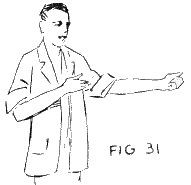
PERFECT THE MOVE OF OPENING THE HAND TO SHOW THAT COIN HAS VANISHED. You must put showmanship into this. Open your hand slowly and gracefully. The hand must never be opened suddenly except in a throwing motion or some special action that requires it. Study this move to give it finish.
Let me say again -- practice before a mirror and do each sleight just as you would if you were actually placing the coin in the left hand. Remember NOT to look at the opposite end of your effect. Do the moves
NATURALLY.
3 -- Front Flat Palm Vanish.
Use the Two Finger Balance for holding coin and showing it to audience. Figure 32.
As you turn hand over and bring it toward left hand, apparently to place coin in left hand, bend your second and third fingers inward to palm of hand. Figure 33.

Press coin into palm of hand and then straighten fingers. Coin is now held by the Front Flat Palm method. Audience thinks you have placed coin in left hand and are not aware that you have it concealed in right hand. Figure 34.
In each Vanish, you continue movement of right hand toward left, of course, after you have vanished the coin into your right hand. You pretend to close left hand over coin and open right hand. Then open left hand slowly and show that coin has disappeared.
4 -- Front Finger Palm Vanish.
Hold coin in Front Finger Palm position in right hand. Show coin plainly to audience, holding both hands out toward them. Figure 35.
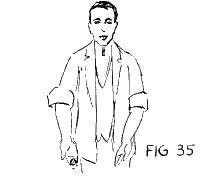
Turn right hand over into left hand as if to drop coin there. Figure 36. Remove right hand with coin still Front Finger Palmed. Then curl third finger inward and conceal coin by the Closed Finger Palm method (Figure 15). This method makes it natural for you to point at left hand with right index finger. Open left hand and coin is gone.
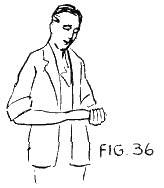
A modification of this Vanish may be made in this way:
Start with the coin in the center of right palm. Slant fingers downward slightly so that coin slides down to the position for the Front Finger Palm. Grip coin there and turn hand over, bringing it toward left hand. Then continue as in the regular Front Finger Palm Vanish.
The effect to the audience is that the coin continued to slide from the right hand into the left. Do not hesitate in turning of right hand toward left and the illusion is perfect.
5 -- Thumb Grip Vanish.
Hold coin in position at base of first finger of right hand. Show to audience in this position. Figure 37.
Turn hand over toward left as though to let coin fall into left hand. As hand turns, hold coin in place with right thumb. Figure 38.
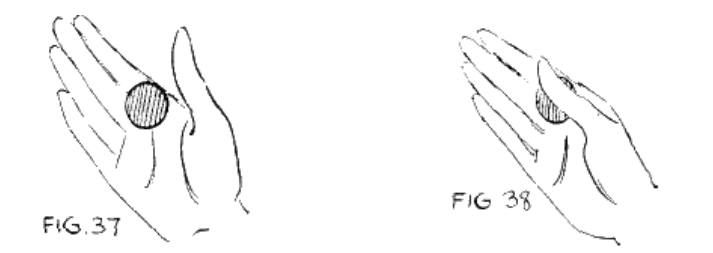
Bạn đang đọc truyện trên: truyentop.pro